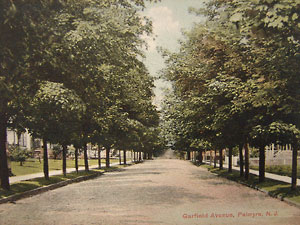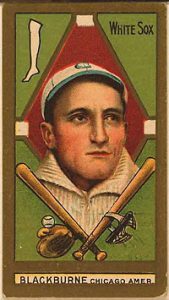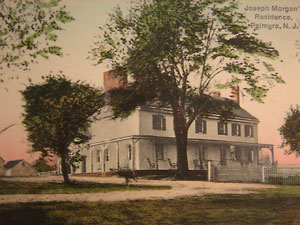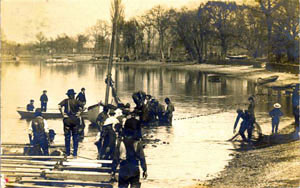Palmyra, NJ | View Map

View of Garfield Avenue, Palmyra, c. 1917. The generous setback requirements for residential structures and wide shaded avenues are examples of “modern” town amenities. The street is named for President James Garfield who was assassinated in 1881. Credit: Burlington County Library, Historic Postcard Collection
The compact borough of Palmyra is strategically situated at the confluence of Pennsauken Creek and the Delaware River at the southern tip of Burlington County. The first European settlers were Swedes who established a colony along the Delaware River in the seventeenth century. English Quakers succeeded the Swedes, and in 1694 the area became part of Chester Township, one of Burlington County’s original townships.
In 1834, the Camden & Amboy Railroad built a station in the area, which was then sparsely settled farmland. By the mid-1800s, as the railroad and steamboats made access to Philadelphia easier, a real estate boom flourished along this stretch of the river. During the same period, the neighboring villages of Beverly, Delanco, Riverside, Riverton, and Florence were created.

A rare 1911 baseball card featuring Russell “Lena” Blackburne of the Chicago White Sox. Credit: Library of Congress
Palmyra began as a small railroad junction named Texas, in honor of that territory’s recent (1845) entry into the Union. Philadelphia entrepreneur Joseph Souder decided that the new rail access and proximity to river transport would attract buyers. He purchased a hundred acres of farmland between the railroad and the Delaware in 1849 and mapped out streets and building lots. To enhance the area’s appeal, the village was renamed Palmyra after a famous trading center in ancient Syria.
Palmyra grew slowly at first, but the immensely popular 1876 Philadelphia Centennial Exposition seems to have provided a boost to the area. The population doubled to 600 by 1883, when two dozen trains a day passed through town. By the 1890s, Palmyra had 2,000 residents and a thriving local economy. Mills and factories turned out cut glass, washing machines, hosiery, iron and steel castings, among other products.
Palmyra was the home of major league baseball player Russell ‘Lena’ Blackburne (1886–1968). Blackburne made pitching history in 1938 when he discovered a local mud that made new baseballs less slippery and easier to throw. All major league baseball teams now use “Lena Blackburne Baseball Rubbing Mud,” produced in Burlington County. Blackburne, an outfielder, began his major league career with the Chicago White Sox. He later managed the White Sox and coached the Philadelphia Athletics.

The Toy-Morgan House (c. 1761) was built by descendants of Swedish settlers and has long been a landmark along this stretch of the river. Much of Palmyra was once part of Toy and Morgan family lands. Credit: Burlington County Library, Historic Postcard Collection
Palmyra is located opposite the Tacony neighborhood of Philadelphia at one of the narrowest points of the river between Burlington and Port Richmond. Despite the proximity to Philadelphia, there were few places to cross the Delaware until the early twentieth century. In the 1920s, Palmyra businessmen started a successful car ferry from Eight Mile Point to booming northeast Philadelphia across the river. A few years later, they financed and built the Tacony-Palmyra Bridge, only the second automobile bridge over the Delaware. Rudolph Modjeski, one of the twentieth century’s foremost bridge engineers, designed the structure, which opened in 1929. NJ Route 73 connects the two cities. Passenger rail service returned to Palmyra in 2004 with the opening of the New Jersey River Line light rail system, which connects towns along the 34-mile corridor between Camden and Trenton.
Today, Palmyra is a residential community of 7,419. The borough is 2.4 square miles in area and is bordered by Riverton Borough, Cinnaminson Township, and Camden County. Palmyra was established as a township in 1894 and a borough in 1923.

Setting nets for shad fishing, early twentieth century. Palmyra’s Eight Mile Point was a fishing ground from Colonial times until the mid-twentieth century when pollution decimated the once plentiful shad populations in the Delaware. Credit: Historical Society of Riverton
For more information:
- www.boroughofpalmyra.com
- www.co.burlington.nj.us
- www.burlingtoncountyhistoricalsociety.org
- www.baseball-reference.com
- www.njtransit.com
Banner art: A 1914 postcard view of Broad Street, Palmyra. Credit: Historical Society of Riverton






